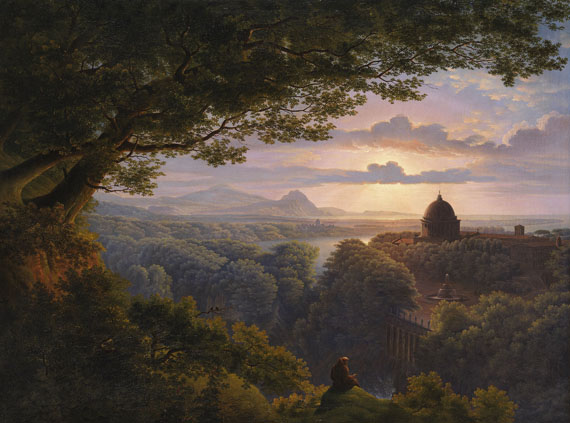Dictionary


German and Scandinavian Classicism
Johann Joachim Winckelmann (1717-68) and Anton Raphael Mengs (1728-79) marked the beginning of Classicism, both on an international and national level. Especially Winckelmann and his idea of a "noble contour" sowed the seeds of the new school, which caught on with, for example, Asmus Jakob Carstens (1754-98). Also Goethe, who had left behind a remarkable oeuvre of drawings, influenced German Classicism with his considerations and writings, at the same time tying in with late Baroque's tendencies: the sculpture's of Georg Raphael Donner had already revealed similar ambitious efforts in the first half of the century, an early classicist architecture was established by Friedrich Wilhelm Freiherr von Erdmannsdorff (1736-1800).
Despite all that, the style's academic variant clearly sought orientation with the French, such as Philipp Friedrich Hetsch (1758-1838) from Stuttgart and Christian Gottlieb Schick (1776-1812). However, a great deal of creative independence was shown in terms of landscapes and portraits: Besides Schick, Johann Heinrich Wilhelm Tischbein (1751-1829) and Angelika Kauffmann (1741-1807) have to be mentioned. As far as the depiction of nature is concerned, a type of "heroic landscape" was established, for example in works by Joseph Anton Koch (1768-1839), who picked out the sublime, the powerful and remote of domestic mountain views as a central topic. Additionally, Johann Christian Reinhart and Jakob Philipp Hackert are worthwhile mentioning. Artists such as Carl Rottmann (1797-1850) focussed on Italian and Greek prospects. A special form of the classicist landscape can be found in sentimental idylls by, for example, Salomon Gessner (1730-88) from Zurich who is regarded as the main representative.
Copenhagen was the center of classicist sculpturing, where, for example the Dane Bert(h)el Thorvaldsen (1770-1844) was working, who was joined by the Swede Johan Tobias Sergel (1740-1814). Johann Heinrich von Dannecker (1758-1841), Johann Gottfried Schadow (1764-1850) and Christian Daniel Rauch (1777-1857) were those who shaped a classicist-realistic style. Leo von Klenze and Karl Friedrich Schinkel were Germany's main classicist architects.
Bonaventura Genelli (1798-1868), Peter von Cornelius (1783-1867) and the Nazarene movement are regarded as exponents of a so-called Late Classicism.
Johann Joachim Winckelmann (1717-68) and Anton Raphael Mengs (1728-79) marked the beginning of Classicism, both on an international and national level. Especially Winckelmann and his idea of a "noble contour" sowed the seeds of the new school, which caught on with, for example, Asmus Jakob Carstens (1754-98). Also Goethe, who had left behind a remarkable oeuvre of drawings, influenced German Classicism with his considerations and writings, at the same time tying in with late Baroque's tendencies: the sculpture's of Georg Raphael Donner had already revealed similar ambitious efforts in the first half of the century, an early classicist architecture was established by Friedrich Wilhelm Freiherr von Erdmannsdorff (1736-1800).
Despite all that, the style's academic variant clearly sought orientation with the French, such as Philipp Friedrich Hetsch (1758-1838) from Stuttgart and Christian Gottlieb Schick (1776-1812). However, a great deal of creative independence was shown in terms of landscapes and portraits: Besides Schick, Johann Heinrich Wilhelm Tischbein (1751-1829) and Angelika Kauffmann (1741-1807) have to be mentioned. As far as the depiction of nature is concerned, a type of "heroic landscape" was established, for example in works by Joseph Anton Koch (1768-1839), who picked out the sublime, the powerful and remote of domestic mountain views as a central topic. Additionally, Johann Christian Reinhart and Jakob Philipp Hackert are worthwhile mentioning. Artists such as Carl Rottmann (1797-1850) focussed on Italian and Greek prospects. A special form of the classicist landscape can be found in sentimental idylls by, for example, Salomon Gessner (1730-88) from Zurich who is regarded as the main representative.
Copenhagen was the center of classicist sculpturing, where, for example the Dane Bert(h)el Thorvaldsen (1770-1844) was working, who was joined by the Swede Johan Tobias Sergel (1740-1814). Johann Heinrich von Dannecker (1758-1841), Johann Gottfried Schadow (1764-1850) and Christian Daniel Rauch (1777-1857) were those who shaped a classicist-realistic style. Leo von Klenze and Karl Friedrich Schinkel were Germany's main classicist architects.
Bonaventura Genelli (1798-1868), Peter von Cornelius (1783-1867) and the Nazarene movement are regarded as exponents of a so-called Late Classicism.
Offers
Headquarters
Joseph-Wild-Str. 18
81829 Munich
Phone: +49 89 55 244-0
Fax: +49 89 55 244-177
info@kettererkunst.de
Louisa von Saucken / Undine Schleifer
Holstenwall 5
20355 Hamburg
Phone: +49 40 37 49 61-0
Fax: +49 40 37 49 61-66
infohamburg@kettererkunst.de
Dr. Simone Wiechers / Nane Schlage
Fasanenstr. 70
10719 Berlin
Phone: +49 30 88 67 53-63
Fax: +49 30 88 67 56-43
infoberlin@kettererkunst.de
Cordula Lichtenberg
Gertrudenstraße 24-28
50667 Cologne
Phone: +49 221 510 908-15
infokoeln@kettererkunst.de
Hessen
Rhineland-Palatinate
Miriam Heß
Phone: +49 62 21 58 80-038
Fax: +49 62 21 58 80-595
infoheidelberg@kettererkunst.de
We will inform you in time.




